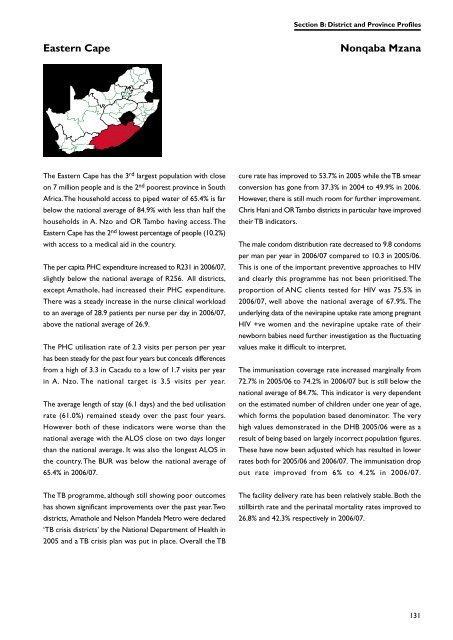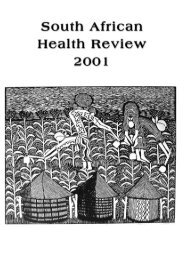DHB 2006/07 - Health Systems Trust
DHB 2006/07 - Health Systems Trust
DHB 2006/07 - Health Systems Trust
Create successful ePaper yourself
Turn your PDF publications into a flip-book with our unique Google optimized e-Paper software.
Section B: District and Province Profiles<br />
Eastern Cape<br />
Nonqaba Mzana<br />
The Eastern Cape has the 3 rd largest population with close<br />
on 7 million people and is the 2 nd poorest province in South<br />
Africa. The household access to piped water of 65.4% is far<br />
below the national average of 84.9% with less than half the<br />
households in A. Nzo and OR Tambo having access. The<br />
Eastern Cape has the 2 nd lowest percentage of people (10.2%)<br />
with access to a medical aid in the country.<br />
The per capita PHC expenditure increased to R231 in <strong>2006</strong>/<strong>07</strong>,<br />
slightly below the national average of R256. All districts,<br />
except Amathole, had increased their PHC expenditure.<br />
There was a steady increase in the nurse clinical workload<br />
to an average of 28.9 patients per nurse per day in <strong>2006</strong>/<strong>07</strong>,<br />
above the national average of 26.9.<br />
The PHC utilisation rate of 2.3 visits per person per year<br />
has been steady for the past four years but conceals differences<br />
from a high of 3.3 in Cacadu to a low of 1.7 visits per year<br />
in A. Nzo. The national target is 3.5 visits per year.<br />
The average length of stay (6.1 days) and the bed utilisation<br />
rate (61.0%) remained steady over the past four years.<br />
However both of these indicators were worse than the<br />
national average with the ALOS close on two days longer<br />
than the national average. It was also the longest ALOS in<br />
the country. The BUR was below the national average of<br />
65.4% in <strong>2006</strong>/<strong>07</strong>.<br />
cure rate has improved to 53.7% in 2005 while the TB smear<br />
conversion has gone from 37.3% in 2004 to 49.9% in <strong>2006</strong>.<br />
However, there is still much room for further improvement.<br />
Chris Hani and OR Tambo districts in particular have improved<br />
their TB indicators.<br />
The male condom distribution rate decreased to 9.8 condoms<br />
per man per year in <strong>2006</strong>/<strong>07</strong> compared to 10.3 in 2005/06.<br />
This is one of the important preventive approaches to HIV<br />
and clearly this programme has not been prioritised. The<br />
proportion of ANC clients tested for HIV was 75.5% in<br />
<strong>2006</strong>/<strong>07</strong>, well above the national average of 67.9%. The<br />
underlying data of the nevirapine uptake rate among pregnant<br />
HIV +ve women and the nevirapine uptake rate of their<br />
newborn babies need further investigation as the fluctuating<br />
values make it difficult to interpret.<br />
The immunisation coverage rate increased marginally from<br />
72.7% in 2005/06 to 74.2% in <strong>2006</strong>/<strong>07</strong> but is still below the<br />
national average of 84.7%. This indicator is very dependent<br />
on the estimated number of children under one year of age,<br />
which forms the population based denominator. The very<br />
high values demonstrated in the <strong>DHB</strong> 2005/06 were as a<br />
result of being based on largely incorrect population figures.<br />
These have now been adjusted which has resulted in lower<br />
rates both for 2005/06 and <strong>2006</strong>/<strong>07</strong>. The immunisation drop<br />
out rate improved from 6% to 4.2% in <strong>2006</strong>/<strong>07</strong>.<br />
The TB programme, although still showing poor outcomes<br />
has shown significant improvements over the past year. Two<br />
districts, Amathole and Nelson Mandela Metro were declared<br />
‘TB crisis districts’ by the National Department of <strong>Health</strong> in<br />
2005 and a TB crisis plan was put in place. Overall the TB<br />
The facility delivery rate has been relatively stable. Both the<br />
stillbirth rate and the perinatal mortality rates improved to<br />
26.8% and 42.3% respectively in <strong>2006</strong>/<strong>07</strong>.<br />
131

















